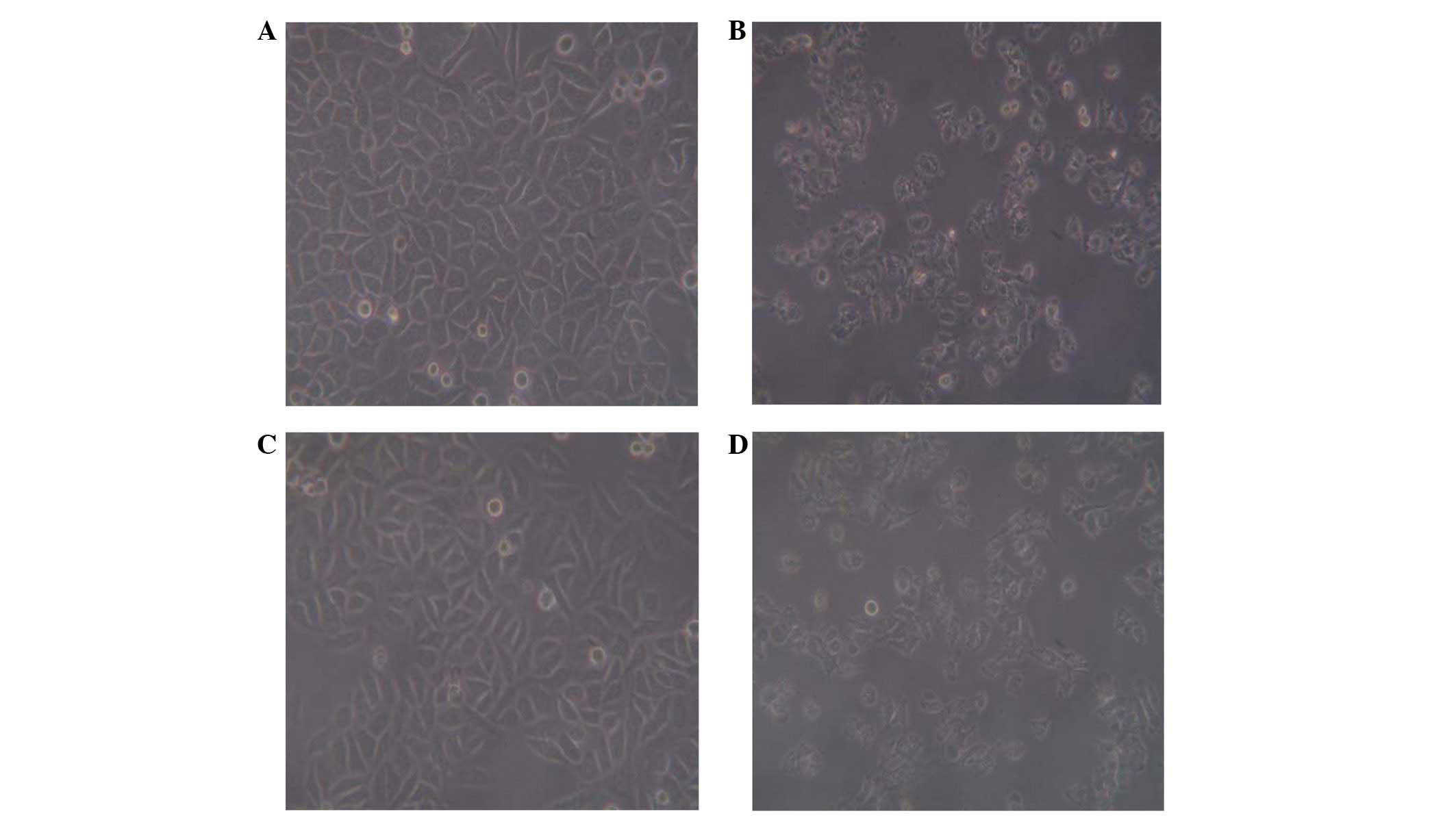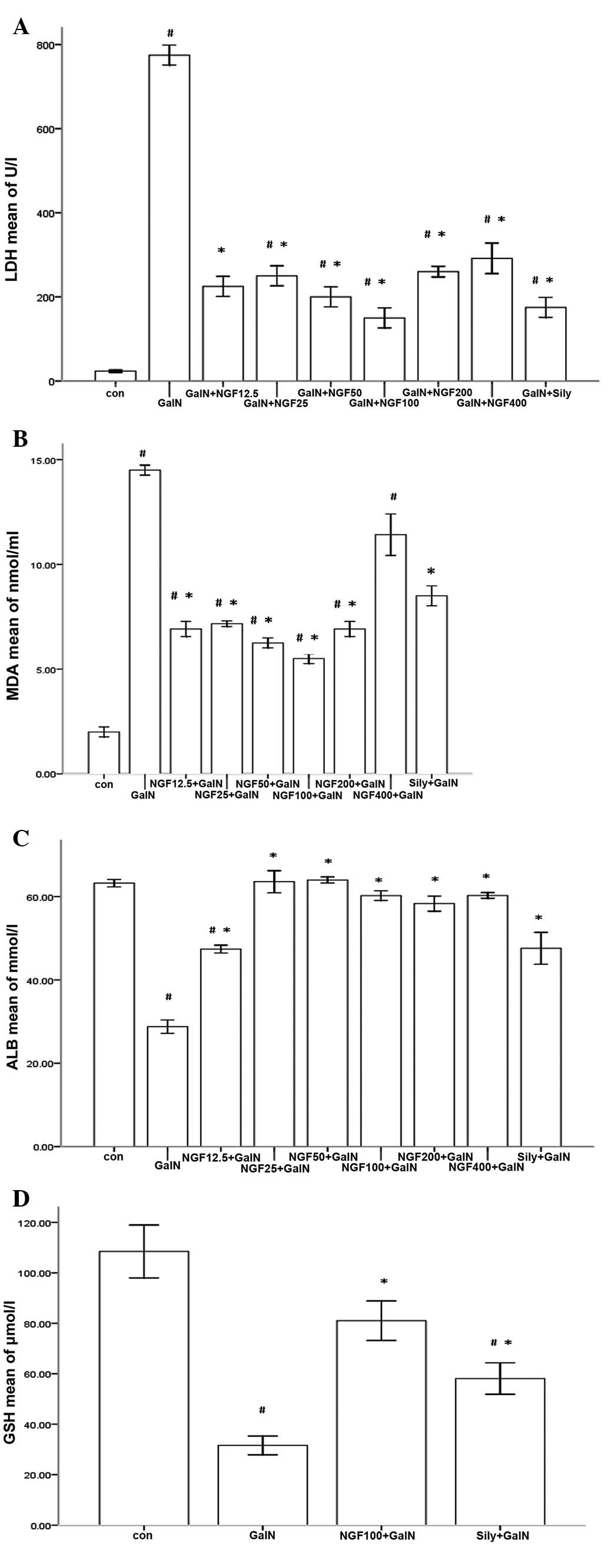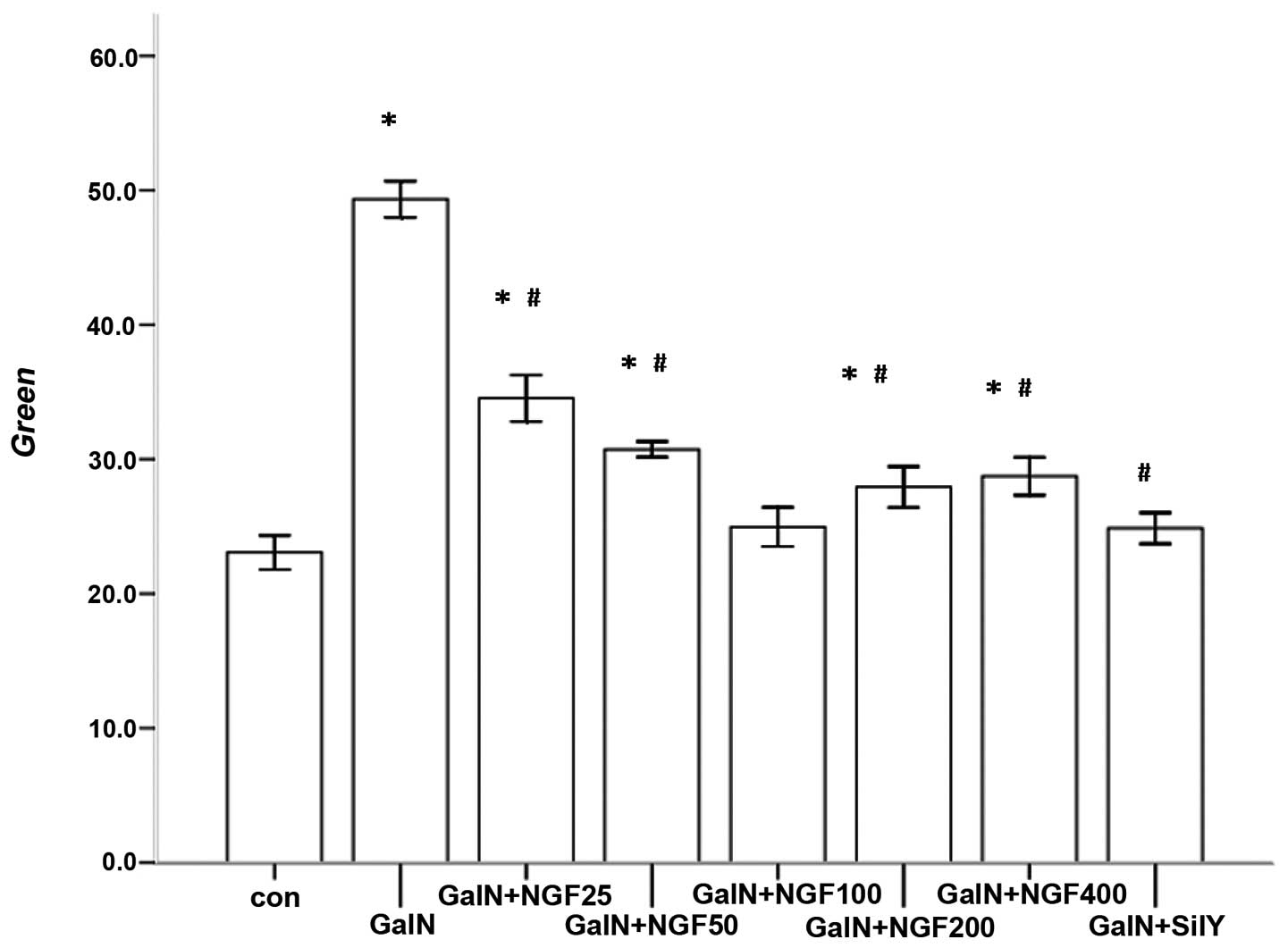β-Nerve growth factor attenuates hepatocyte injury induced by D-galactosamine in vitro via TrkANGFR
- Authors:
- Published online on: July 16, 2013 https://doi.org/10.3892/mmr.2013.1590
- Pages: 813-817
Abstract
Introduction
The liver is predominantly comprised of polarized epithelial cells, which regulate the intermediary metabolism, detoxification, the manufacture of critical circulating proteins and the production of bile for digestion (1). However, the liver is susceptible to different types of injuries. Hepatocyte apoptosis is considered to be a pivotal pathological process in a variety of liver injuries. The damaged hepatocytes release apoptotic bodies that are engulfed by resident kupffer and hepatic stellate cells (HSCs), which release chemokines and cytokines that subsequently promote HSC activation and transdifferentiation into myofibroblasts, resulting in dysregulated hepatic fibrosis and cirrhosis (2). Cirrhosis is the worst consequence of continuous liver injury, as it may lead to portal hypertension, liver failure and mortality (3). The optimal therapeutic strategy for several liver diseases is to directly inhibit the mechanism that triggers the liver injury. Clinically, antiviral therapies have been demonstrated to be effective for viral hepatitis. However, there are no effective treatments for a variety of liver diseases, including liver fibrosis, and patients with hepatitis C (HCV) or hepatitis B viruses (HBV) who are unresponsive to antiviral therapies. For these patients, taking effective measures to protect the hepatocytes from injury and inhibit apoptosis are important therapeutic strategies (4).
Nerve growth factor (NGF) and its receptors are produced in nervous and non-nervous system cells, which regulate the differentiation, survival, development and apoptosis processes of cells by means of autocrine or paracrine signaling and are also involved in wound healing and tissue remodeling processes. The biological effects of NGF are mediated through two membrane receptors, the tropomyosin tyrosine kinase-A nerve growth factor receptor (TrkANGFR) and the p75 pan-neurotrophin receptor (p75NTR) (5). Recent evidence has suggested that NGF has broader physiological effects, which may be involved in the liver injury-repair process, since its mRNA and protein expression levels become elevated whilst regenerating hepatocytes. Furthermore, activated HSCs induced by lead nitrate in rats (6), partial hepatectomy (7) or CCl4 treatment in mice (8) and exogenous recombinant NGF may promote activated HSC apoptosis (8,9). Certain authors have demonstrated that manipulation of the NGF/p75NTR axis represents a novel means for regulating the progression and resolution of liver fibrosis (10). However, little is known with regards to the protective effect of NGF on damaged hepatocytes.
In this study, we provide evidence that human hepatocyte L-02 cells express NGF and its receptors, TrkANGFR and p75NTR. Furthermore, we report that exogenous human recombinant β-NGF attenuates injury and inhibits the apoptosis of L-02 cells induced by D-galactosamine (D-GalN), and that the protective mechanism of β-NGF is likely to be mediated through the TrkANGFR signaling pathway.
Materials and methods
Chemicals
DMEM, fetal bovine serum (FBS), penicillin, streptomycin, 0.25% EDTA-Trypsin, D-GalN and silymarin (Sily) were purchased from Life Technologies (Gibco, Carlsbad, CA, USA). Recombinant human β-NGF was obtained from R&D Systems (Minneapolis, MN, USA) and rabbit polyclonal anti-NGF, anti-TrkANGFR and anti-p75NTR antibodies were derived from Boster Bioengineering Limited Company (Wuhan, China). Human albumin (ALB), lactate dehydrogenase (LDH) activity, malondialdehyde (MDA) and glutathione (GSH) assay kits were supplied by Jiancheng Bioengineering Institute (Nanjing, China). The BD™ MitoScreen (JC-1) kit was purchased from BD Biosciences (Franklin Lakes, NJ, USA). The cell proliferation reagent XTT was purchased from Bio Basic Inc (BBI, Markham, ON, Canada). The MaxVision™ kit and 3,3′-diaminobenzidine (DAB) were purchased from the Maixin Bioengineering Institute (Fuzhou, China).
Cell cultures
The human liver L-02 cell line (Institute of Biochemistry and Cell Biology, SIBS, Shanghai, China) was cultured in DMEM medium supplemented with 10% FBS, 100 U/ml penicillin and 100 μg/ml streptomycin, and maintained in a humidified 5% CO2 incubator at 37°C. The culture medium was replaced every 2–3 days. The cells were sub-cultured and allowed to adhere for 24 h prior to performing subsequent experiments.
Immunocytochemistry
L-02 cells (1×105 cells/well) were seeded into 6-well plates with coverslips and fixed with 4% formaldehyde in PBS at room temperature (RT) for 15 min, then washed three times with PBS. L-02 cells were incubated overnight at 4°C with primary rabbit polyclonal antibodies against NGF or TrkANGFR, or p75NTR diluted (1:100) in PBS containing 0.1% Triton X-100 detergent. Cells were washed three times with PBS and subsequently incubated for 30 min at RT with the MaxVision kit (HRP-Polymer anti-rabbit lgG) according to the manufacturer’s instructions. The signal was detected using DAB as the chromogen. Counterstaining was performed with Mayer’s hematoxylin (Invitrogen, Carlsbad, CA, USA). Negative controls were obtained by omitting the primary antibody. Stained cells were visualized using an inverted optical microscope (Olympus CK40, Tokyo, Japan).
Light microscopy
L-02 cells were pretreated with β-NGF for 30 min and subsequently incubated with D-GalN for 24 h. The alterations to cell morphology were viewed using an inverted Olympus CK40 microscope. Microphotographs were captured with a digital Canon EOS 600D camera (Canon, Tokyo, Japan).
Cell proliferation assay
The primary culture of L-02 cells were seeded into 96-well plates at a density of 5×103 cells/well and pretreated with β-NGF at various concentrations (0, 25, 50, 100, 200 and 400 μg/l) for 30 min prior to incubation with D-GalN (40 mmol/l). Sily (100 mg/l) was used as a positive control. In order to evaluate whether the neurotrophin receptors, TrkANGFR and/or p75NTR, were involved in the response of the L-02 cells to β-NGF, the cells were cultured in the presence of β-NGF (100 μg/l) and anti-TrkANGFR (200 μg/l) or anti-p75NTR (200 μg/l) for 30 min, then D-GalN was added and incubated for a further 24 h. Following this period, the XTT reagent was added to the cultured medium and incubated in a humidified atmosphere for 4 h. The absorbance of the samples was measured using a microplate reader at the dual wavelength mode of 450 and 630 nm, respectively. The experiment was performed in tetramerous and repeated three times with consistent results.
Biochemical assay
Hepatocyte toxicity was determined by LDH activity and the concentration of MDA in the culture medium. The production of ALB, an important functional marker of hepatocytes, was evaluated using a colorimetric method. The antioxidative condition of hepatocytes was determined by measuring the levels of GSH in the cell lysate.
Mitochondrial membrane potential (MMP)
The change in MMP was evaluated from uptake of JC-1 (5,5′,6,6′-tetrachloro-1,1′,3,3′-tetraethyl-benzimidazolylcarbocyanine iodide), a cationic lipophilic fluorescent probe. In intact cells, the healthy mitochondrial membrane was polarized and JC-1 was rapidly taken up by mitochondria. This uptake increased the concentration gradient of JC-1, which led to the formation of JC-1 aggregates in the mitochondrial matrix. JC-1 aggregates exhibited a red spectral shift resulting in higher levels of red fluorescence (Emmax 590 nm). In cells with an altered MMP, JC-1 did not aggregate in the mitochondria and thus remained in the cytoplasm as monomers, producing green fluorescence (Emmax 527 nm). L-02 cells were incubated with JC-1 at 37°C for 15 min and centrifuged at 400 × g for 5 min at RT. Subsequently, the cells were carefully removed, the supernatant was discarded and the cells were resuspended in the JC-1 working solution. L-02 cells were analyzed by flow cytometry at the excitation and emission wavelengths of 527 and 590 nm, respectively.
Statistical analysis
All values are expressed as the mean ± SD. Differences between the groups were compared using a one-way analysis of variance (ANOVA) test. P<0.05 was considered to indicate a statistically significant difference.
Results
Expression of NGF, TrkANGFR and p75NTR in L-02 cells
The expression of NGF, TrkANGFR and p75NTR was examined in L-02 cells using immunocytochemistry. Immunostained NGF was detected prominently in the cytoplasm and on the nuclei, and TrkANGFR and p75NTR immunoreactivities were observed on the cell membrane and in the cytoplasm of L-02 cells (Fig. 1).
Morphological changes of L-02 cells in the culture medium
The morphology of L-02 cells incubated with D-GalN demonstrated discontinuities of the cytoplasm membrane, its spherical shape and highly granular cytoplasm formed a notable contrast to the intact cells. β-NGF and Sily were capable of markedly improving the D-GalN-induced morphological changes to L-02 cells (Fig. 2).
β-NGF promotes the proliferation of L-02 cells
Exogenous human recombinant β-NGF was capable of promoting the proliferation of D-GalN-injured L-02 cells in a dose-dependent manner. We observed a statistically significant increase at concentrations between 25–400 μg/l. β-NGF and Sily significantly promoted the proliferation of L-02 cells compared with D-GalN alone. However, there were no differences between the β-NGF and Sily groups (Fig. 3A). To demonstrate which signaling pathway contributed to β-NGF irritating the proliferation events of L-02 cells, we inhibited the biological activity of TrkANGFR with anti-TrkANGFR and observed that the promoted proliferation effect of β-NGF on L-02 cells was blocked. However, pretreatment of L-02 cells with the anti-p75NTR antibody, which neutralized the binding of β-NGF to p75NTR, did not affect the proliferation of L-02 cells responding to β-NGF (Fig. 3B). These data suggested that TrkANGFR participates in the response of the L-02 cells to β-NGF.
Biochemical changes of β-NGF on D-GalN-induced L-02 cells
D-GalN severely injured L-02 cells in the primary culture following 24 h incubation. D-GalN induced a marked increase in LDH and MDA activity in the supernatant (Fig. 4A and B). Furthermore, ALB production and the GSH content of the cells decreased (Fig. 4C and D). β-NGF reduced the levels of LDH and MDA released from D-GalN-induced L-02 cells, while ALB synthesis was markedly enhanced and the cell content of GSH was increased.
Effect of β-NGF on the MMP of D-GalN-induced L-02 cells
The MMP was measured using the fluorescent probe JC-1. There was low accumulation of JC-1 in the mitochondrial matrix of L-02 cells incubated with D-GalN. However, β-NGF significantly decreased the permeability of the inner mitochondrial membrane and JC-1 accumulated in the mitochondrial matrix, recovering the MMP damaged by D-GalN. There was no statistical difference in JC-1 accumulation in the mitochondrial matrix between the β-NGF and Sily treatment groups (Fig. 5).
Discussion
D-GalN is frequently used in liver damage models to replicate the effects of human viral hepatitis, which induces diffuse hepatic injury by depleting uridine nucleotides, resulting in the inhibition of the synthesis of messenger RNA and subsequent proteins (11). A hepatotoxic dose of D-GalN induces hepatic tissue lesions associated with a decrease in GSH synthesis or an increase in the breakdown of GSH (12,13). Mitochondrial permeability transition (MPT) leads to the dissipation of MMP and is considered to be a fundamental mechanism of cell apoptosis or necrosis (14). Liver regeneration driven by hepatocyte proliferation is required for hepatic tissue injury-repair and survival following acute/chronic liver injury (15,16).
This study demonstrated that pretreatment with exogenous human recombinant β-NGF promoted the proliferation and inhibited apoptosis of D-GalN-induced L-02 cells compared with D-GalN alone. LDH is an important marker for hepatocyte injury. We identified that D-GalN significantly increased the activity of LDH in the L-02 cell culture medium. However, pretreatment with β-NGF markedly decreased the LDH activity of D-GalN-induced L-02 cells. MDA is a marker for lipid peroxidation. Pretreatment with β-NGF reduced the concentration of MDA and increased intracellular GSH content compared with D-GalN alone. The production of ALB by D-GalN-incubated L-02 cells was markedly reduced, but β-NGF may improve the synthesis of ALB by D-GalN-induced L-02 cells. However, high MMP in L-02 cells was completely eradicated by D-GalN. The opening of high-conductance MPT pores increases the permeability of the inner-mitochondrial membrane, which results in the collapse of the MMP, a disruption in ionic homeostasis, cytochrome C release and subsequently, apoptosis (17). However, pretreatment with β-NGF may prevent MPT pores from opening by repairing the plasma membrane injured by GalN-induced L-02 cells, which may be achieved by enhancing GSH synthesis. The integrity of the cells was damaged by D-GalN, whose representations were associated with discontinuities in the plasma membrane, a spherical shape and a highly granular cytoplasm when compared with intact cells (18). Treatment with β-NGF markedly reduced D-GalN-induced morphological changes to the cells. These results indicated that β-NGF is a potential drug for protecting L-02 cells from D-GalN-induced injury.
To investigate the mechanism by which β-NGF promotes the proliferation of L-02 cells, we performed immunocytochemical staining for NGF, TrkANGFR and p75NTR in L-02 cells. We discovered that L-02 cells expressed NGF, TrkANGFR and the p75NTR protein. In order to evaluate which, or both, neurotrophin receptors were involved in the response of L-02 cells to β-NGF, L-02 cells were pretreated with β-NGF and anti-TrkANGFR or anti-p75NTR for 30 min and subsequently damaged by D-GalN for 24 h. The promoted proliferation effect of β-NGF on the L-02 cells was inhibited by anti-TrkANGFR. Notably, this selectively inhibited β-NGF binding to p75NTR with anti-p75NTR, yet it did not prevent β-NGF from promoting the proliferation of L-02 cells. These data demonstrate that TrkANGFR may be involved in the response of L-02 cells to β-NGF.
In conclusion, in this study we demonstrated that NGF and its receptors, TrkANGFR and p75NTR, are expressed in L-02 cells. Exogenous human recombinant β-NGF exerts a hepatoprotective effect on D-GalN-induced L-02 cell injury. The beneficial effects of this agent may be partially due to the promotion of L-02 cell proliferation and the inhibition of apoptosis via the NGF/TrkANGFR signaling pathway, which increases GSH synthesis, attenuates the disruption of oxidative stress and lipid peroxidation and reduces damage to the plasma membrane. Thus, β-NGF is a viable therapeutic option for various liver diseases.
References
|
Lalor PF and Adams DH: The liver: a model of organ-specific lymphocyte recruitment. Expert Rev Mol Med. 12:1–16. 2002. | |
|
Friedman SL: Hepatic stellate cells: protean, multifunctional, and enigmatic cells of the liver. Physiol Rev. 88:125–172. 2008. View Article : Google Scholar : PubMed/NCBI | |
|
Malhi H, Guicciardi ME and Gores GJ: Hepatocyte death: a clear and present danger. Physiol Rev. 90:1165–1194. 2010. View Article : Google Scholar : PubMed/NCBI | |
|
Cohen-Naftaly M and Friedman SL: Current status of novel antifibrotic therapies in patients with chronic liver disease. Ther Adv Gastroenterol. 4:391–417. 2011. View Article : Google Scholar : PubMed/NCBI | |
|
Micera A, Lambiase A, Stampachiacchiere B, et al: Nerve growth factor and tissue repair remodeling: trkA(NGFR) and p75(NTR), two receptors one fate. Cytokine Growth Factor Rev. 18:245–256. 2007. View Article : Google Scholar : PubMed/NCBI | |
|
Nemoto K, Miyata S, Nemoto F, et al: Gene expression of neurotrophins and their receptors in lead nitrate-induced rat liver hyperplasia. Biochem Biophys Res Commun. 275:472–476. 2000. View Article : Google Scholar : PubMed/NCBI | |
|
Asai K, Tamakawa S, Yamamoto M, et al: Activated hepatic stellate cells overexpress p75NTR after partial hepatectomy and undergo apoptosis on nerve growth factor stimulation. Liver Int. 26:595–603. 2006. View Article : Google Scholar : PubMed/NCBI | |
|
Oakley F, Trim N, Constandinou CM, et al: Hepatocytes express nerve growth factor during liver injury: evidence for paracrine regulation of hepatic stellate cell apoptosis. Am J Pathol. 163:1849–1858. 2003. View Article : Google Scholar : PubMed/NCBI | |
|
Trim N, Morgan S, Evans M, et al: Hepatic stellate cells express the low affinity nerve growth factor receptor p75 and undergo apoptosis in response to nerve growth factor stimulation. Am J Pathol. 156:1235–1243. 2000. View Article : Google Scholar : PubMed/NCBI | |
|
Kendall TJ, Hennedige S, Aucott RL, et al: p75 Neurotrophin receptor signaling regulates hepatic myofibroblast proliferation and apoptosis in recovery from rodent liver fibrosis. Hepatology. 49:901–910. 2009. View Article : Google Scholar | |
|
Keppler DO, Rudigier JF, Bischoff E and Decker KF: The trapping of uridine phosphates by D-galactosamine. D-galactosamine, and 2-deoxy-D-galactose A study on the mechanism of galactosamine hepatitis. Eur J Biochem. 17:246–253. 1970. View Article : Google Scholar : PubMed/NCBI | |
|
Sun F, Hamagawa E, Tsutsui C, et al: Evaluation of oxidative stress during apoptosis and necrosis caused by D-galactosamine in rat liver. Biochem Pharmacol. 65:101–107. 2003. View Article : Google Scholar : PubMed/NCBI | |
|
McMillan JM and Jollow DJ: Galactosamine hepatotoxicity: effect of galactosamine on glutathione resynthesis on rat hepatocyte cultures. Toxicol Appl Pharmacl. 115:234–240. 1992. View Article : Google Scholar : PubMed/NCBI | |
|
Kon K, Kim JS, Jaeschke H and Lemasters JJ: Mitochondrial permeability transition in acetaminophen-induced necrotic and apoptotis of cultured mouse hepatocytes. Hepatology. 40:1170–1179. 2004. View Article : Google Scholar : PubMed/NCBI | |
|
Issa R, Zhou X, Trim N, et al: Mutation in collagen-1 that confers resistence to the action of collagenase results in failure of recovery from CCl4-induced liver fibrosis, persistence of activated hepatic stellate cells, and diminished hepatocyte regeneration. FASEB J. 17:47–49. 2003.PubMed/NCBI | |
|
Taub R: Liver regeneration: from myth to mechanism. Nat Rev Mol Cell Biol. 5:836–847. 2004. View Article : Google Scholar : PubMed/NCBI | |
|
Drahota Z, Kriváková P, Cervinková Z, et al: Tert-butyl hydroperoxide selectively inhibits mitochondrial respiratory-chain enzymes in isolated rat hepatocytes. Physiol Res. 54:67–72. 2005. | |
|
Kucera O, Lotková H, Kand’ár R, et al: The model of D-galactosamine-induced injury of rat hepatocytes in primary culture. Acta Medica (Hradec Kralove). 49:59–65. 2006.PubMed/NCBI |














